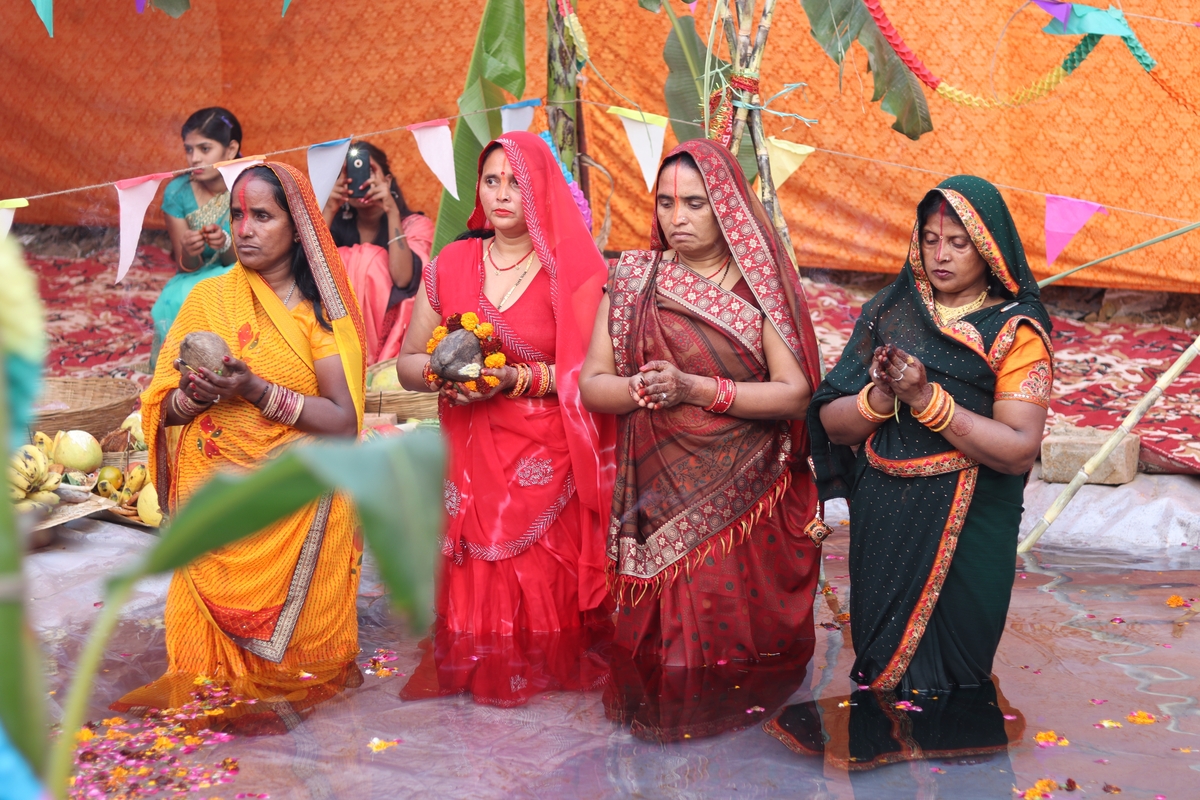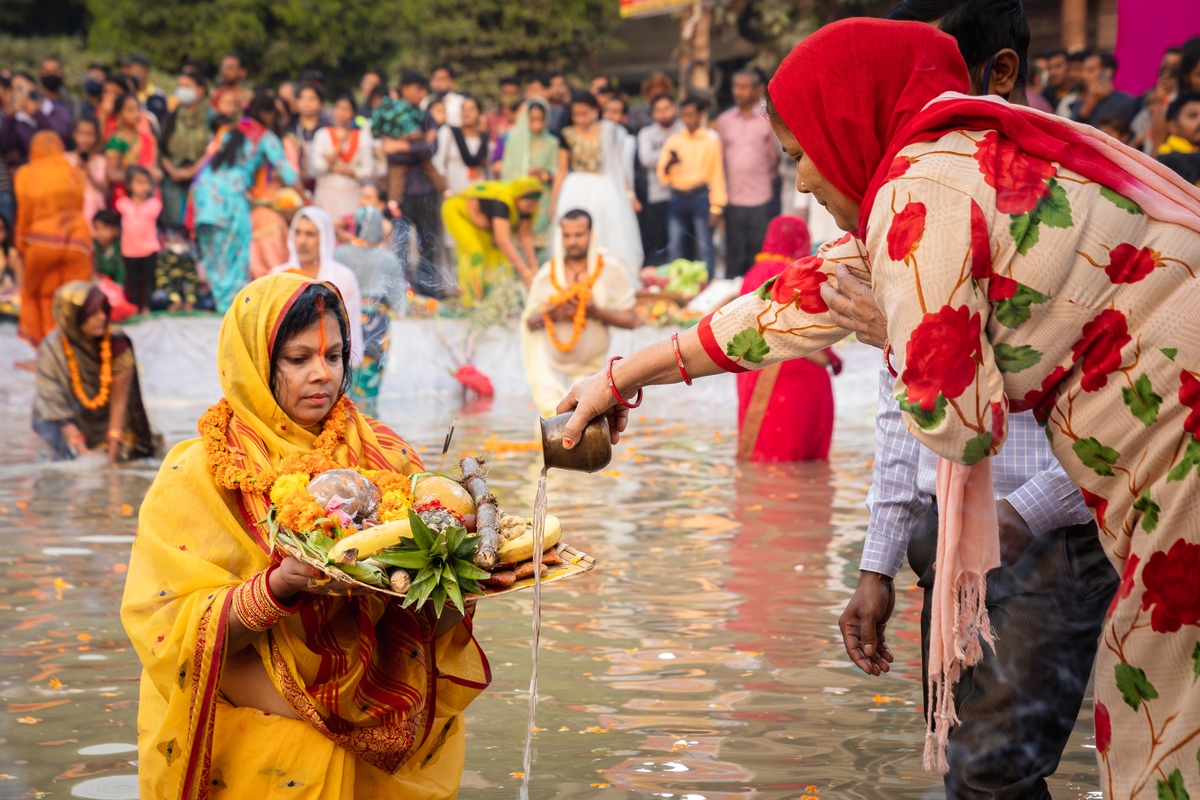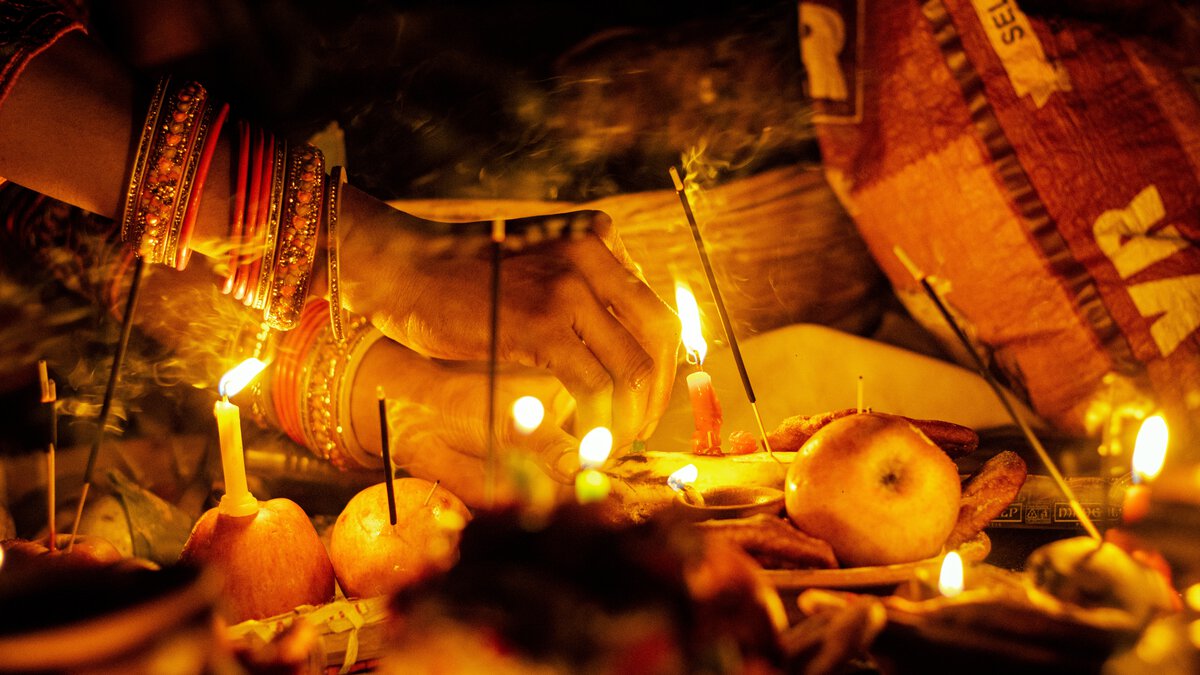November 16, 2023
Chhath Puja 2025: A Celebration of Sun, Soul, and Sacred Waters
CM Content Team


View all
140+
Resorts
November 16, 2023
CM Content Team
In the liminal hours before dawn, when darkness surrenders to the promise of light, millions gather at the edges of India's sacred rivers. They come not for spectacle, but for something far more profound: a covenant with the cosmos itself. Chhath Puja represents one of humanity's oldest dialogues with nature, a four-day ritual where devotion flows as ceaselessly as the Ganges.
As 2025 approaches, this extraordinary festival continues to captivate not merely through its rituals, but through its radical simplicity: the acknowledgement that all life springs from the sun, and gratitude remains our highest offering.

The rhythms of Chhath Puja follow not the Gregorian precision of modern calendars, but the ancient wisdom of lunar cycles. In 2025, this sacred observance unfolds across four transformative days, beginning on Saturday, October 25th and culminating on Tuesday, October 28th. Each day carries its own spiritual gravity, building toward moments of transcendent communion between devotee and deity.

Nahay Khay arrives on October 25th, the day of purification, when the Ganges becomes not merely water, but liquid sanctity. As sunrise breaks at 6:41 AM, devotees immerse themselves in the river's embrace, cleansing body and spirit before sunset at 6:06 PM ushers in the evening meal: simple, sattvic, prepared with reverence.
Lohanda and Kharna follow on October 26th, marking the commencement of the fast that will test both body and resolve. The day stretches from sunrise at 6:41 AM through sunset at 6:05 PM, when devotees break their waterless fast with kheer sweetened by jaggery, a taste of divinity on the tongue.
Sandhya Arghya transforms October 27th into poetry written in light and water. Sunrise at 6:42 AM heralds a day of preparation, but it is sunset at 6:05 PM that witnesses the festival's most spectacular moment: when hundreds wade into the Ganges to offer prayers to the descending sun, their collective devotion rippling across the water like liquid prayer.
Usha Arghya concludes the observance on October 28th, as sunrise at 6:42 AM becomes the focal point of 36 hours of fasting and faith. Before the first light touches the horizon, devotees return to the water's edge, completing the sacred circle that began two days prior. By sunset at 6:04 PM, the fast is broken, the vows fulfilled, the cosmic debt acknowledged.
These timings are not mere suggestions but sacred appointments, coordinates where human devotion intersects with celestial movements. The precision matters because Chhath Puja recognises what modern life often forgets: we remain, fundamentally, creatures of light, dependent on the sun's generosity for every breath, every heartbeat, every moment of existence.

Every great festival emerges from the soil of story, and Chhath Puja's roots reach deep into the mythological bedrock of Hindu tradition. These are not children's tales but foundational narratives that explain why millions willingly undertake such rigorous observance.
The Rigveda, humanity's oldest surviving religious text, already speaks of sun worship with reverence and awe. But Chhath Puja's specific mythology weaves through several powerful legends, each adding dimension to the festival's significance.
Consider Draupadi, the Pandava queen who knew suffering intimately during her family's thirteen-year exile. When darkness seemed absolute and solutions impossibly distant, sage Dhaumya advised the ritual that would become Chhath Puja. Through unwavering devotion to Surya Dev, the Pandavas found the strength to endure their trials. The festival thus becomes a testament to faith's power during life's most challenging passages.
Then there is Queen Priyavrata's wife, whose childlessness carried not merely personal sorrow but dynastic implications. When conventional solutions failed, she turned to Chhathi Maiya with absolute surrender. Her son's birth validated what devotees have known for millennia: some blessings arrive only when we acknowledge forces greater than ourselves.
Karna's story adds another layer. The tragic hero of the Mahabharata, blessed by Surya Dev himself, demonstrated through daily sun worship the discipline and devotion that would define his character. His connection to the Sun God was not metaphorical but biological, yet he earned divine favour through consistent, reverent practice rather than birthright alone.
Perhaps most touching is Sita's observance after returning from her Lankan captivity. Having endured exile, abduction, and trial by fire, she might have been forgiven for bitterness. Instead, she performed Chhath Puja, praying not for personal vindication but for Ayodhya's welfare and her people's prosperity. This selflessness, this orientation toward collective well-being, remains central to Chhath Puja's enduring appeal.
These stories are not ancient history but living theology, explaining why contemporary devotees willingly undertake such demanding rituals. They suggest that Chhath Puja offers something increasingly rare in modern life: a direct relationship with forces that transcend the individual ego, connecting personal devotion to cosmic order.

In an era of increasing religious commodification, where spirituality often gets reduced to wellness trends and Instagram aesthetics, Chhath Puja remains defiantly authentic. Its significance operates on multiple registers simultaneously: personal, communal, ecological, and cosmic.
Chhath Puja demands something modern life rarely requires: genuine sacrifice. The 36-hour waterless fast is not performative spirituality but a profound physical commitment. Devotees, predominantly women, voluntarily surrender comfort, convenience, and bodily ease for something they deem more valuable: divine blessing for their families' welfare.
This personal austerity gains deeper meaning through its collective expression. Unlike many Hindu festivals centred around temple worship, Chhath Puja unfolds in public spaces (riverbanks, ponds, lakes) where individual devotion becomes visible, mutual, and reinforcing. The festival creates what sociologists call "collective effervescence," those rare moments when individual consciousness merges into something larger, generating an almost tangible spiritual energy.
One of Chhath Puja's most revolutionary aspects is its radical democracy. The festival recognises no caste distinctions, no economic hierarchies, no social stratification. At the water's edge, all devotees are equal supplicants before the sun. No priestly intermediaries are required; no elaborate temple structures mediate the divine encounter. This direct, unmediated relationship between devotee and deity represents something profoundly egalitarian in a culture often criticised for social hierarchy.
This democratic character extends to gender as well. While women typically lead the observance, the festival honours feminine strength and spiritual authority in ways rare in patriarchal structures. The vrat-keeping women become, for these four days, their families' spiritual anchors, demonstrating forms of power that transcend conventional authority.
Perhaps most relevant for our climate-conscious age, Chhath Puja embodies ecological awareness centuries before "sustainability" became fashionable. The festival worships natural elements (sun, water, earth) not as resources to exploit but as sacred entities deserving reverence. Devotees use biodegradable materials exclusively: bamboo baskets, earthen lamps, and organic offerings. The ritual itself is an act of environmental gratitude, acknowledging humanity's dependence on natural systems.
The Ganges is not merely a convenient location but a living goddess, Mother Ganga, whose waters purify and sanctify. This understanding, that nature possesses intrinsic sanctity beyond human utility, offers profound lessons for contemporary environmental ethics. Chhath Puja suggests that true sustainability requires not technological solutions alone but a fundamental reorientation in how we perceive our relationship with the natural world.
For the states of Bihar, Uttar Pradesh, and Jharkhand, Chhath Puja represents cultural identity in its most concentrated form. The festival preserves folk traditions (songs, food preparations, ritual knowledge) that might otherwise vanish under modernity's homogenising pressure. Each generation learns from the previous, creating living continuity with ancestors who performed identical rituals centuries ago.
The traditional foods alone tell stories: Thekua, those sweet wheat cookies, require specific preparation techniques passed through families. The prasad offerings (sugarcane, coconuts, bananas) connect devotees to agricultural cycles and seasonal awareness. The folk songs sung at the ghats carry dialects and melodies unique to specific regions, linguistic diversity in an increasingly uniform world.
Finally, Chhath Puja's deepest significance may be its cosmic perspective. The festival asks devotees to acknowledge their profound dependence on forces utterly beyond human control. Every atom in our bodies was forged in stellar furnaces; every breath we take involves photosynthesis powered by solar radiation. Chhath Puja ritualises this scientific truth, transforming abstract astrophysics into visceral, embodied recognition.
In our anthropocentric age, when technology creates illusions of human omnipotence, Chhath Puja offers corrective humility. We are not the universe's centre but its temporary inhabitants, wholly dependent on systems we didn't create and cannot ultimately control. This recognition breeds not despair but appropriate gratitude: the emotional foundation for wisdom.

Understanding Chhath Puja requires moving beyond dates and mythology to the rituals themselves: the specific gestures through which devotion becomes tangible.
The festival opens with ritual bathing, but calling it merely "bathing" diminishes its significance. When devotees enter the Ganges on Nahay Khay, they're not simply washing but undergoing symbolic rebirth. The river strips away not just physical impurities but spiritual detritus: the accumulated karma of ordinary life.
The meal that follows must meet exacting standards. Sattvic food only: bottle gourd curry, rice, chana dal prepared without onion, garlic, or excessive spices. This dietary restriction is not arbitrary but an intentional simplification, reducing sensory stimulation to focus attention on spiritual rather than gustatory pleasure. The body becomes a temple being prepared for divinity's approach.
Kharna's waterless fast represents the festival's most physically demanding element. From dawn until sunset, devotees consume nothing: no water, no food, nothing that might dilute their spiritual focus. The body's complaints become background noise to prayer's persistent whisper.
When evening finally arrives, the fast breaks not with indulgence but with specific, symbolically charged foods. The kheer made with jaggery tastes of earth's sweetness, unrefined and honest. Chapati and banana complete the meal, each element chosen for purity rather than pleasure. This breaking of fast establishes the devotee's commitment, demonstrating they possess the resolve necessary for the greater ordeals ahead.
If Chhath Puja has a climactic moment visible to cameras and comprehensible to outsiders, it is Sandhya Arghya. As sunset approaches, the ghats transform. Hundreds, sometimes thousands of devotees wade into the Ganges, carrying beautifully arranged bamboo baskets filled with prasad. The sight is almost hallucinogenic in its colour and motion: saffron and red and yellow saris against the darkening water, diyas flickering like earthbound stars, the collective sound of prayer rolling across the river like audible light.
Devotees stand waist-deep in the current, offering water to the setting sun. The gesture looks simple (cupped hands pouring water toward the horizon) but carries profound symbolism. They are offering the life-giver back to itself, acknowledging that all water, all life, originates in solar energy. It's a moment of perfect circular logic made beautiful through ritual.
The prasad baskets themselves are minor masterpieces of folk art. Arranged with mathematical precision, they contain seasonal fruits, Thekua, coconut, sugarcane, with each item placed with care that borders on meditation. This attention to aesthetic detail matters because beauty itself becomes an offering, suggesting that devotion requires our finest efforts, our most careful attention.
The final morning requires devotees to return to the water before dawn, carrying the same baskets from the previous evening. In darkness, they wait, and as the first light breaks across the Ganges, they offer prayers to the rising sun.
This moment (sunrise after 36 hours without food or water) must induce altered states of consciousness. The body, depleted and purified, becomes unusually receptive. The mind, freed from its ordinary preoccupations, achieves unusual clarity. When the sun finally rises, devotees don't merely see it; they experience it with an intensity modern life rarely permits.
The conclusion of Usha Arghya brings not celebration but quiet satisfaction. The fast breaks with Prasad, the vows are fulfilled, the cosmic debt is acknowledged. Devotees return to ordinary life transformed, carrying within them the memory of these four days when they touched something eternal.

Chhath Puja's celebration extends across India's heartland, with each location adding its own character to this ancient observance. The festival finds its most fervent expression in the states of Bihar, Uttar Pradesh, and Jharkhand, where it represents not merely a religious event but the very essence of cultural identity.
Bihar stands as Chhath Puja's undisputed heartland, where the festival transcends religion to become a defining element of regional consciousness. In Patna, the capital city, the ghats along the Ganges transform into vast congregational spaces. Thousands gather at Gandhi Ghat, Adalat Ghat, and Collectorate Ghat, creating scenes of devotion that stretch as far as the eye can see. The city essentially pauses during these four days, with businesses closing and public life reorganising around the festival's rhythms.
In smaller towns and villages across Bihar, every water body becomes sacred during Chhath Puja. Ponds, rivers, and even artificially created water tanks host the rituals, proving that devotion requires no grand architecture, only faith and flowing water. The folk songs of Chhath, passed through generations, echo across Bihar's landscape, creating a sonic tapestry that binds communities together.
Uttar Pradesh's celebration of Chhath Puja centres significantly on Varanasi, where the festival gains additional spiritual weight from the city's own sacred geography. The ghats of Varanasi (Dashashwamedh, Assi, Rajghat, Kedar, Harishchandra) become stages for devotion, their ancient stones connecting contemporary worshippers to millennia of spiritual practice. Here, the Ganges flows not merely as water but as liquid divinity, Mother Ganga in her most powerful manifestation.
Beyond Varanasi, cities like Gorakhpur, Ballia, and Ghazipur witness equally intense celebrations. The eastern districts of Uttar Pradesh, culturally aligned with Bihar, observe Chhath with particular devotion. Urban centres see migrants return to their ancestral villages specifically for the festival, reversing the usual rural-to-urban flow and reaffirming familial and cultural connections.
In Jharkhand's industrial landscape, Chhath Puja creates remarkable contrasts. Cities like Ranchi, Jamshedpur, and Dhanbad, known for steel plants and mining operations, transform during the festival. The Subarnarekha River in Jamshedpur becomes a pilgrimage site, its banks crowded with devotees who bring ancient rituals into conversation with modern industrial life.
The state's celebration demonstrates Chhath Puja's ability to maintain cultural identity even amid rapid modernisation. Factory workers and corporate employees observe the same rigorous fasts and rituals their ancestors performed centuries ago, proving that devotion adapts without compromising its essential character.

The festival's celebration has expanded significantly beyond its traditional geography. In Delhi and the National Capital Region, Chhath Puja has become increasingly prominent, with the Yamuna riverfront and artificial ponds hosting large gatherings. The city's significant Bihari and eastern UP migrant population has transported their cultural practices to the capital, making Chhath a fixture of Delhi's religious calendar.
Mumbai, Kolkata, Bangalore, and other metropolitan centres now witness Chhath celebrations, albeit on smaller scales. Diaspora communities have carried the festival internationally, with observances now occurring in Mauritius, Fiji, Trinidad, and even cities across North America and Europe where Indian communities have established themselves. These international celebrations, often held at lakes or oceanfronts, demonstrate the festival's portability and its importance as a marker of cultural identity for people far from their ancestral homes.
What unites all these diverse locations is the essential spirit of Chhath Puja: devotees standing in water, offering prayers to the sun, acknowledging cosmic debts with unwavering faith. Whether at the sacred ghats of Varanasi or a municipal pond in a distant suburb, the ritual remains fundamentally unchanged, connecting millions across geography and time through shared devotion.
Chhath Puja 2025 arrives in a world increasingly disconnected from natural rhythms, where artificial light obscures the stars and climate-controlled environments make seasons irrelevant.
Against this backdrop, the festival's ancient wisdom becomes not a quaint tradition but an urgent reminder. We remain creatures of the sun, dependent on its generosity for every aspect of existence. Acknowledging this dependence through ritual doesn't diminish human dignity but establishes appropriate humility: the foundation for wisdom.
As devotees wade into sacred waters this October, offering prayers to the setting and rising sun, they perform a gesture as old as consciousness itself: giving thanks for the gift of life, recognising powers greater than ourselves, and maintaining humanity's oldest contract with the cosmos.
In doing so, they preserve not merely cultural tradition but something more fundamental: the recognition that gratitude remains our highest offering to the universe that sustains us.
Mahindra Holidays & Resorts India Ltd. (MHRIL), a part of Leisure and Hospitality sector of the Mahindra Group, offers quality family holidays primarily through vacation ownership memberships and brings to the industry values such as reliability, trust and customer satisfaction. Started in 1996, the company's flagship brand ‘Club Mahindra’, today has over 300,000 members , who can holiday at 140+ resorts in India and abroad.
We use cookies to personalise content and to provide you with an improved user experience.By Continuing to browse this site you consent to the use of cookies.Please visit our cookie policy for further details.

Welcome to ClubMahindra.com In order to provide a personalised experience for you, we use cookies to enable some website functionality. Cookies help us see which articles most interest you; allow you to easily share articles on social media channels; permit us to deliver content personalised to your interests and locations; along with many other site benefits. For more information, please review our Cookie Policy
When you visit any website, it may store or retrieve information on your browser, mostly in the form of cookies. This information might be about you, your preferences or your device and is mostly used to make the site work as you expect it to. The information does not usually directly identify you, but it can give you a more personalized web experience. Because we respect your right to privacy, you can choose not to allow some types of cookies. Click on the different category headings to find out more and change our default settings. However, blocking some types of cookies may impact your experience of the site and the services we are able to offer.
Because we respect your right to privacy, you can choose not to allow some types of cookies and you have the right to withdraw your consent by send a mail to email id [email protected]
These cookies are essential in order to enable you to move around the site and use its features, such as accessing secure areas of the site. Without these cookies, services you have asked for cannot be provided.
These cookies allow us to employ data analytics so we can measure and improve the performance of our site and provide more relevant content to you. These cookies don't collect information that identifies a visitor down to an individual level that is available to us. These cookies are not passing personally identifiable information to any external third party other than in limited cases when we engage a service provider to act on our behalf but who is then unable to use the data for their own purposes.
Performance cookies are generally third-party cookies from vendors we work with or who work on our behalf that collect information about your visit and use of the Club Mahindra website, for instance which pages you visit the most often, and if you get error messages from web pages. These cookies don't collect information that identifies a visitor. All information these cookies collect is anonymous and is only used to improve your overall experience on how the website works. Third party vendors may have access to this data and may use it to improve their overall services and offerings.
Functionality cookies allow a site to remember choices you make (such as your user name, language or the region you are in) and provide more enhanced, personal features. These cookies cannot track your browsing activity on other websites. They don't gather any information about you that could be used for advertising or remembering where you've been on the Internet outside our site.
Third-party advertising and social media cookies are used to (1) deliver advertisements more relevant to you and your interests; (2) limit the number of times you see an advertisement; (3) help measure the effectiveness of the advertising campaign; and (4) understand people's behaviour after they view an advertisement. They are usually placed on behalf of advertising networks with the site operator's permission. They remember that you have visited a site and quite often they will be linked to site functionality provided by the other organization. This may impact the content and messages you see on other websites you visit. If you do not allow these cookies you may not be able to use or see certain these sharing tools content on our website.